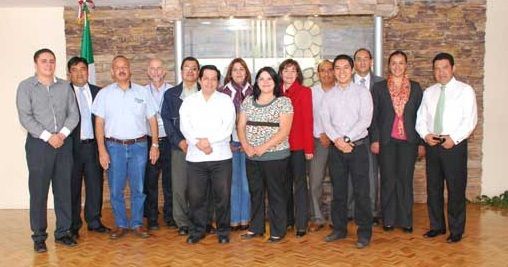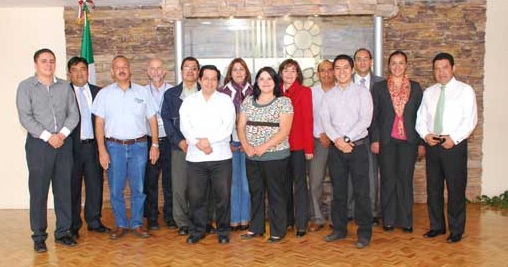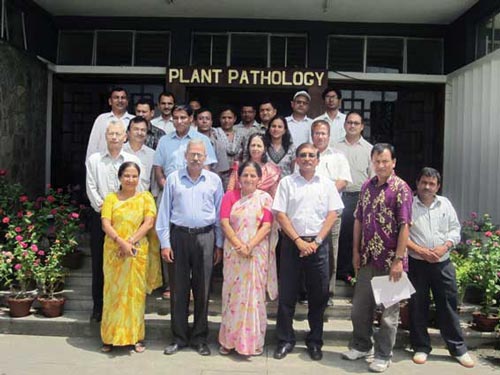Smallholder maize farmers in Zimbabwe lack knowledge of open-pollinated varieties
CIMMYT E-News, vol 4 no. 5, May 2007
OPVs perform as well as hybrids or better under the low-input conditions of many smallholder farmers in Zimbabwe, but farmers need information and training about how properly to use them.
A new study to assess the effectiveness of a large-scale maize seed relief effort in Zimbabwe during 2003-07 shows that, even among vulnerable, small-scale farmers living on the edge of survival under the most difficult conditions, a livelihood-saving technology like quality seed of open-pollinated maize varieties (OPVs) is not enough, without knowledge about how best to use it.
Farmers can save grain of OPVs from their harvest and sow it the following year without the yield or other qualities of the variety diminishing substantially. Hybrids normally yield more than OPVs under favorable conditions, but “recycling” the seed in subsequent seasons will result in a significant loss of that yield and of other advantages; farmers must purchase fresh seed each season to retain them. “Zimbabwe farmers have historically favored hybrids, and they have limited knowledge about OPVs,” says Augustine Langyintuo, CIMMYT socioeconomist and lead author of the study. “Changing economic circumstances in the country have meant that many farmers can no longer purchase fertilizer to take best advantage of hybrid yield potential. We interviewed 597 households in 6 districts of Zimbabwe where a major seed-relief effort had, among other aims, promoted the broader diffusion of OPVs over hybrids, thereby giving smallholder farmers the possibility to save and re-use their own seed without sacrificing their meager yields.”
The seed aid effort, which was funded by British Department for International Development (DfID) and coordinated by the Food and Agricultural Organization (FAO) regional office in Harare, enlisted the assistance of 16 non-government organizations (NGOs) to distribute improved maize seed to more than 25,000 needy farmers. “The average household size in our survey group was 6.5 members, supported by a cultivated farm size of just 1.7 hectares, over 60% of which is planted to maize,” says Langyintuo. “Nearly a third of the households were headed by widowed females, a factor highly correlated with poverty.”
Under the relief program, the NGOs were expected to inform farmers of the types of seed being distributed and the need to select, store, and re-use the seed properly in subsequent seasons. Less than half the beneficiaries in the first year of the program were informed of the type of seeds to be provided, although the proportion increased to more than 60% over time. Information on OPVs was limited to the fact that they can be recycled. Less than half were ever taught how to select or store their seed.
According to Langyintuo, many farmers continue to recycle hybrids, or improperly select OPV grain for future use as seed, or—in the worst cases—eat all their grain and hope for another aid shipment to sow next year. “The relatively well-endowed farmers were more willing to recycle OPV seed. In future efforts, NGOs should perhaps target them to ensure larger-scale spillovers,” he says. “In general, whoever distributes seed of improved OPVs should provide information on proper seed selection and follow up with field-level training. Farmers should also be involved in the choice of the varieties.”
Another key issue to grapple with is the unavailability of OPV seed on the market. This stems from the unwillingness of seed companies to develop and promote OPVs, given the perception that farmers will simply recycle them and never buy fresh seed. “Zimbabwe farmers recycle both OPVs and hybrids, but if given a choice, they will purchase fresh seed whenever they can,” says Langyintuo. “OPVs perform as well as hybrids or better under the low-input conditions of many smallholder farmers in Zimbabwe, so they constitute a good option for such farmers.”
You can view or download the study “Assessment of the effectiveness of maize seed assistance to vulnerable farm households in Zimbabwe.”
For more information: Augustine Langyintuo, socioeconomist (a.langyintuo@cgiar.org)
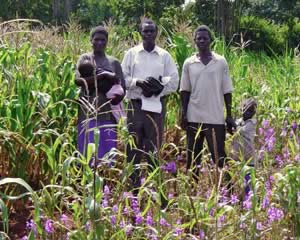 Looks can deceive. Striga, a deadly parasitic plant, produces a lovely flower but sucks the life and yields out of crops across Africa and Asia. A new strain of improved maize seed is helping farmers reclaim their invaded crop lands.
Looks can deceive. Striga, a deadly parasitic plant, produces a lovely flower but sucks the life and yields out of crops across Africa and Asia. A new strain of improved maize seed is helping farmers reclaim their invaded crop lands.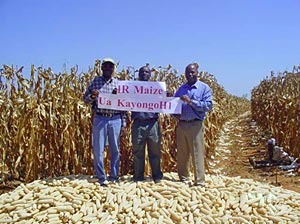
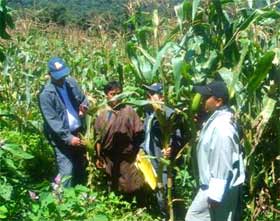 Sandwiched between China and India, the Kingdom of Bhutan is a small country that relies on maize in a big way. But maize yields are typically low due to crop diseases, drought, and poor access to seed of improved varieties, among other reasons. CIMMYT is committed to improving Bhutan’s food security by providing high-yielding, pest-resistant maize varieties to farmers and capacity-building for local scientists.
Sandwiched between China and India, the Kingdom of Bhutan is a small country that relies on maize in a big way. But maize yields are typically low due to crop diseases, drought, and poor access to seed of improved varieties, among other reasons. CIMMYT is committed to improving Bhutan’s food security by providing high-yielding, pest-resistant maize varieties to farmers and capacity-building for local scientists.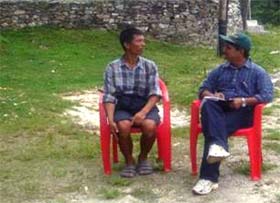
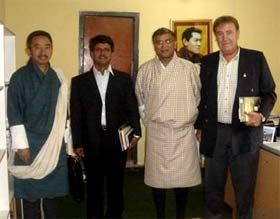 “Our CIMMYT office in Nepal has assisted Bhutan with maize and wheat genetic material, technical backstopping, training, visiting scientist exchange, and in identifying key consultants on research topics such as grey leaf spot and seed production,” says Tiwari.
“Our CIMMYT office in Nepal has assisted Bhutan with maize and wheat genetic material, technical backstopping, training, visiting scientist exchange, and in identifying key consultants on research topics such as grey leaf spot and seed production,” says Tiwari.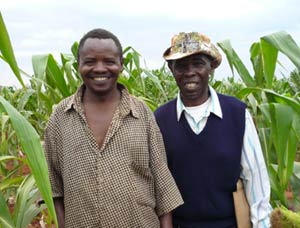 In the 2006-07 cropping season, 82 registered maize seed companies produced the bulk of just over 100,000 tons of improved maize seed that were marketed in the major maize producing countries of eastern and southern Africa (excluding South Africa) — enough to sow 35% of the maize land in those countries.
In the 2006-07 cropping season, 82 registered maize seed companies produced the bulk of just over 100,000 tons of improved maize seed that were marketed in the major maize producing countries of eastern and southern Africa (excluding South Africa) — enough to sow 35% of the maize land in those countries.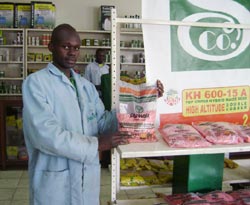
 After decades of stability, world food prices jumped more than 80% in 2008. Recent good harvests have brought prices down, but not to previous, historically-low levels, and most economists expect food costs to remain at much higher levels than before. At any moment catastrophic events like a drought or major crop disease outbreak could shock fragile grain markets and quickly send values skyrocketing anew.
After decades of stability, world food prices jumped more than 80% in 2008. Recent good harvests have brought prices down, but not to previous, historically-low levels, and most economists expect food costs to remain at much higher levels than before. At any moment catastrophic events like a drought or major crop disease outbreak could shock fragile grain markets and quickly send values skyrocketing anew.